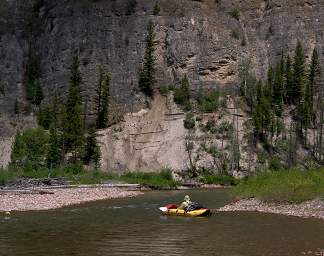

Wayne and I had gotten into the rhythm of Young's Creek, and had enjoyed fishing our way down it. The logjams and portages didn't affect our attitude much, as long as the water beyond looked fishy and the weather was nice. That's one thing not having a schedule does for a trip like this.
We arrived at the confluence of Young's and Danaher creeks around noon. Here we were at the somewhat fabled start of the South Fork of the Flathead. The water was low, about as low as one would want if floating. It was historically the week after peak flow, but peak flow had come and gone almost a month earlier.
My boat was leaking pretty badly -- I had to pump it up every half-hour or so, and every time I stopped to fish. That got old pretty fast. In addition, my waders were leaking somewhere. The weather was hot so that wasn't a big deal, but it was a bit uncomfortable and annoying.
As we floated past Flatiron Mountain just below the confluence a packer was headed down the trail leading a string of mules. I remembered the place, having ridden and lead our loaded horses down the same trail a few years before.
 |
 |
| Wayne on the upper South Fork | Packer |
We made camp near Gordon Creek where there is a huge almost-logjam. We decided to take a layover day the next day to patch my boat. While the patch was drying, we would explore Gordon Creek.
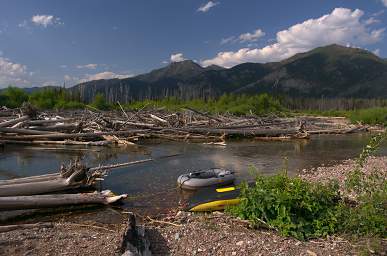 |
 |
| Gordon Creek Camp | |
While unpacking and preparing dinner, Wayne asked me if I still had "the fish". The day before, before we hit the Young's Creek canyon and its portages, we had been planning on a fish-augmented dinner. I had kept one fish but had asked Wayne if he could put it in his plastic bag, as I couldn't locate mine. He thought he'd given it back to me. Neither one of us could locate "the fish", and we both thought the other had it. And neither one of us could remember disposing of it. Hmmm...
Wayne made dinner again; I made a cherry cobbler for dessert. Unfortunately, my dutch oven is 10" in diameter. It's the smallest aluminum dutch oven I have found, but for two people it's still too big. I almost had an 8" one custom made, but never got around to it. Maybe I should still do that.
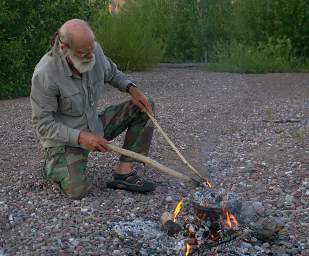 |
 |
| Baking Cobbler | Cobbler |
The next morning we patched my boat and Wayne's. Mine had a too-big-to-ignore leak where four seams come together in the front, about the worst place to have a leak. The seam had blown out, probably a result of age -- the raft is 22 years old and about at the end of its useful life in terms of materials, particularly the seam glue, ageing. Wayne had a tear in one of the inflated deck covers at the bow of his boat. The glue in my patch kit had been opened a few years before, and there was only about a quarter of the tube left. I had asked Wayne to bring an extra tube of barge cement with him for me, so I decided to use that. We used the same cement to patch his boat.
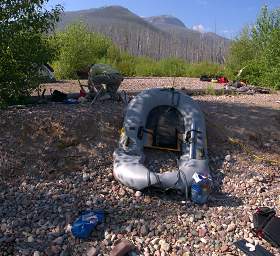 |
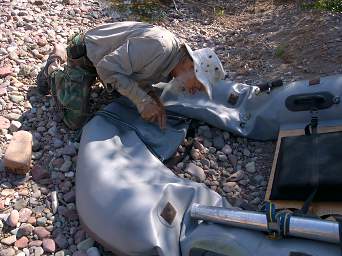 |
| Setup To Patch | Rolling The Patch |
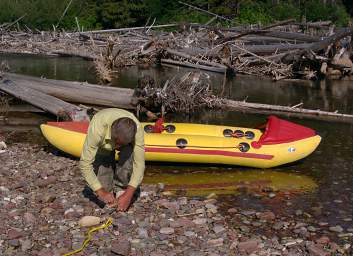 |
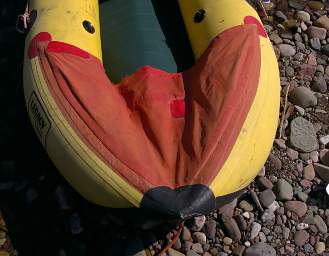 |
| Preparing a Patch | Wayne's Patch |
I also patched my waders, which had started leaking on both legs along one of their seams. Wayne asked what kind of waders they were. They were labelled "Caddis," and I had bought them at a less-than-best-quality local sporting goods outlet primarily for use measuring streamflows for water conservation in-stream flow leases. They seemed like the right thing to bring on this trip instead of my full neoprene ones or the purely cloth ones which had uncomfortable nylon feet. They looked well-made on the surface, but when compared with Wayne's they were clearly inferior. I found the holes and patched them with Aquaseal.
 |
| Patched Waders |
While griping about the construction quality of my waders, Wayne said "They're probably made by the same people who made my boots." He'd purchased a cheap pair of wading boots for this trip from the bargin bin someplace for $15, and they were already showing signs of wear. He checked the labels and sure enough, they both said "Caddis." The Caddis website says something like "The first waders designed to be your last." NOT !!! They didn't leak from tears or abuse. They leaked on the stitched seams. Buyer beware...
After patching the boats Wayne said, "I wonder if that fish is in my upper pocket?" Meaning the upper pouch at the back of his fishing vest. It was... and was well on its way to becoming one with the rest of the earth. Good thing it was in a plastic bag. We donated it to the eagles and ospreys and burned the bag.
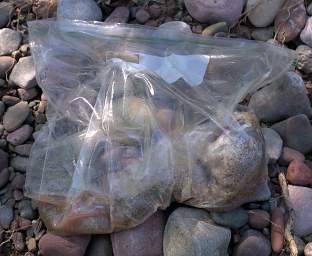 |
| Lost Fish |
Wayne decided to take a bath before heading out to explore Gordon Creek. The warm weather made a bath sound like a good idea, but the river was still plenty cold.
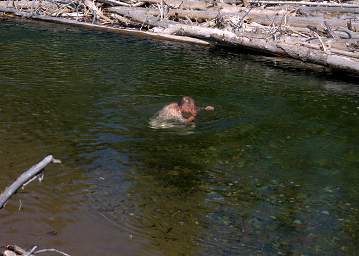 |
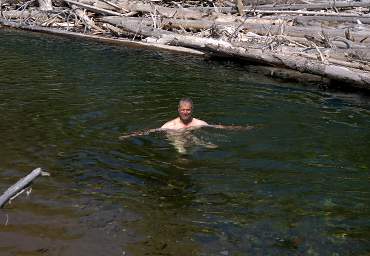 |
| Wayne taking a Bath | |
We crossed the river, found the mainline trail along the river, and hiked down to where it crossed Gordon Creek. Wayne's knee bothers him after a lot of walking, so he started there and fished up the creek. I hiked up the creek about three miles and started fishing down.
Gordon Creek is a pretty creek, and looked to be flowing about the same amount as Young's. But it had a whole lot more downed timber, at least in the part I worked my way through. I spent a lot of time just working from one spot to the next. Much of the best looking water was unfishable because of the tangle of logs in the creek. The fishing was about the same as in Young's Creek. Nothing particularly big but a good number of fat healthy fish.
 |
| Gordon Creek |
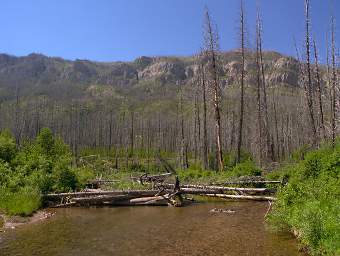 |
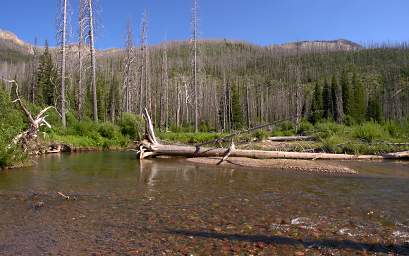 |
 |
| Gordon Creek Cutthroat |
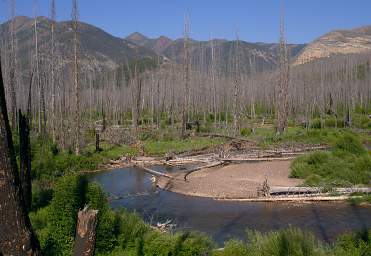 |
 |
| Wayne on Gordon Creek | |
Back at camp that evening, Wayne cooked us another gormet meal.
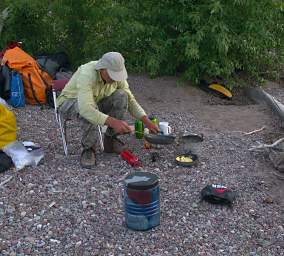 |
| Cooking Dinner |
We put the tent up every night, but we usually didn't put the rain-fly on. The weather was warm and didn't cool too much overnight, and the fly just makes it warmer in the tent. We used the tent primarily for mosquito protection. They weren't bad but for about an hour in the morning and evening, but they were an annoyance then.
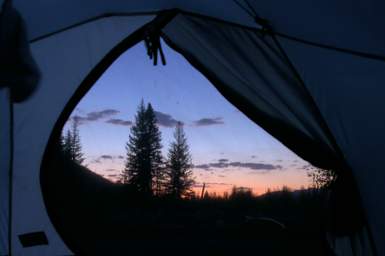 |
| Sunset From Tent |
The next day we encountered another party in small alpackarafts, this time a couple with their two golden retrievers. The dogs appeared to be swimming the South Fork, or most of it. The owners said that was pretty much the case, although the dogs got to ride in the alpackas when they were tired. What a life! Our dog Max would have thought he was in seventh heaven.
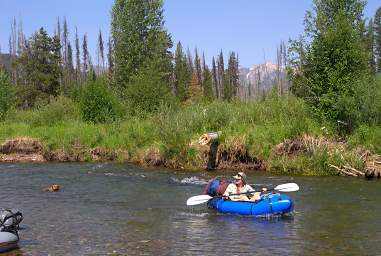 |
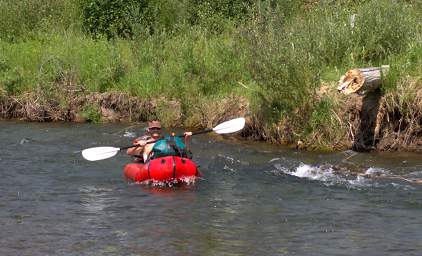 |
| Packboats with Dogs | |
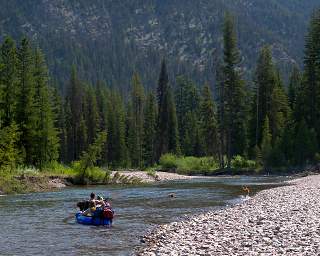 |
We headed on down the river, and it soon became apparent that my patch wasn't holding. I was having to re-inflate my boat every fifteen minutes or so, and whenever I stopped to fish. It was a royal pain in the neck. My waders were leaking again as well.
We passed under the Big Prairie bridge and continued down the river. We were thinking we would stop at White River for another layover day, but we went right on by. The fishing was pretty mediocre; we caught fish, but they didn't have much size to them.
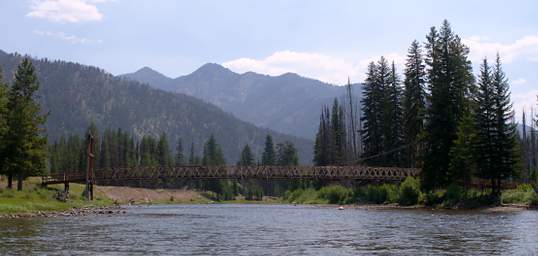 |
| Big Prairie Bridge |
 |
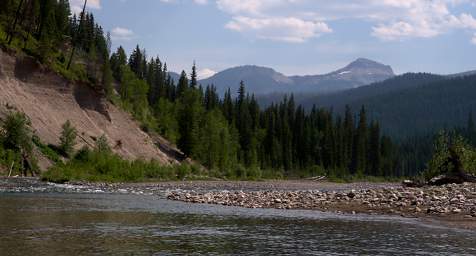 |
| Looking south up the river | |
We saw the folks with the golden retrievers again, but this time the dogs were apparently tired and riding instead of swimming. They seemed quite content to serve as lookouts in the boats.
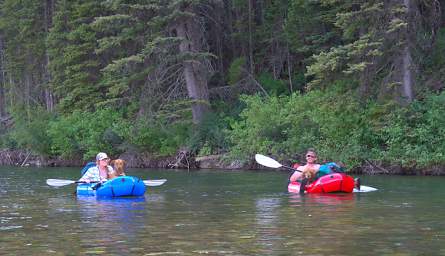 |
| Packboats with Dogs |
Even this far down, the river was still scratchy. It's shaping up to be a really dry year, which could mean a lot of fires.
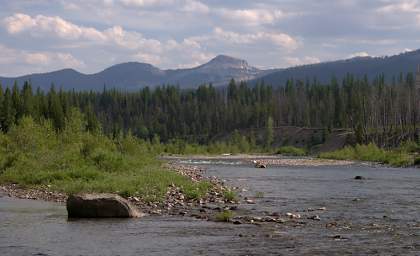 |
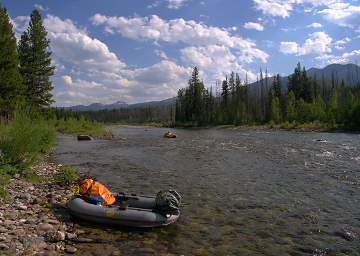 |
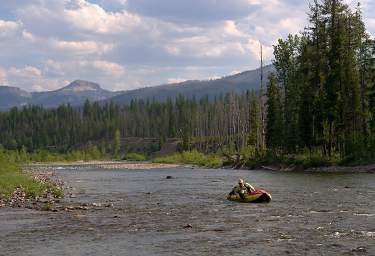 |
 |
| Scratchy | |
We continued on down and eventually made camp a few miles above Helen Creek. I pulled off my patch to let it dry for the night before repatching. The old glue peeled off pretty easily, indicating it most likely wasn't compatible with the material of the raft itself.
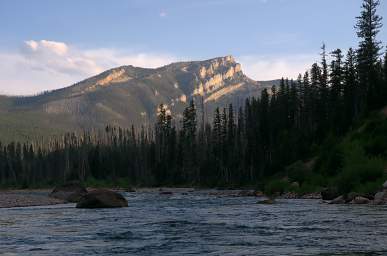 |
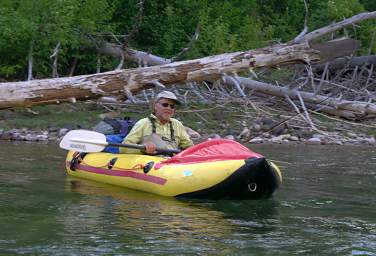 |
| Evening | Wayne |
 |
| Patch Removed |
The next morning I repatched my boat, this time using the remainder of the old cement from my boat's original repair kit. It seemed to stick a lot better. It turns out my boat is made of PVC type material, and Wayne's is a chlorosulfonated polyethelene (Hypalon) type. Rubber glues like barge cement work on the latter, but not the former. The folks at Northwest River Supplies have a great video about which adhesive to use where. They also have a great selection of articles on boat maintenance and repair.
After getting the boat patched I decided to take a hike for the rest of the day. It was overcast and looked like rain. I hiked down to the Helen Creek trail and turned up it, headed towards Pagoda Mountain. I figured I wasn't likely to make it to the top, but hoped to get to where I could see for a ways.
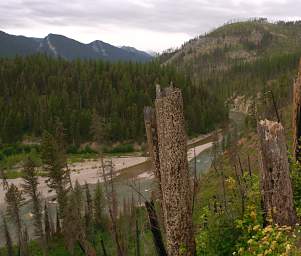 |
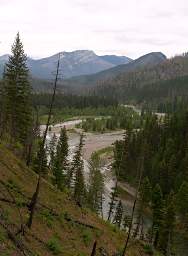 |
| Toward Helen Cr | The South Fork |
I went through a stand of recently burned trees where the older larch had survived but not much else. It was a great example of how fire-adapted trees like larch and ponderosa pine survive low intensity fires, leading to open forests with large tree spacings.
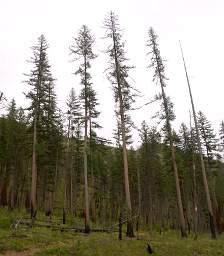 |
| Fire Adapted Larch |
A bit further on I came to a place where a grizzly had dug up some ground squirrels. Or at least tried; I couldn't tell if it was successful or not.
 |
| Griz Dug Out Rodents |
As usual, there were plenty of wildflowers to puzzle over.
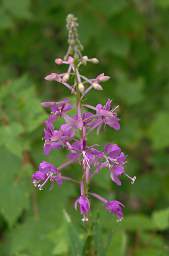 |
| Fireweed |
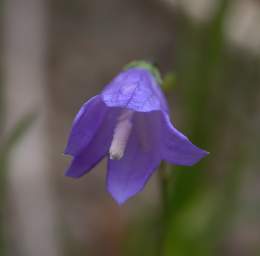 |
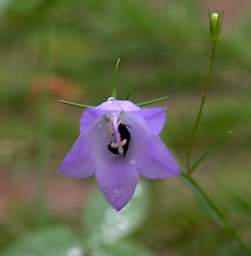 |
| Harebell | |
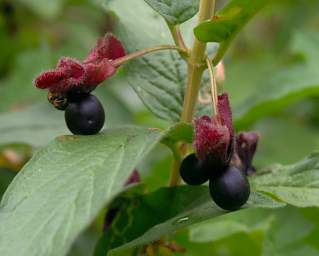 |
| Twin Berry |
 |
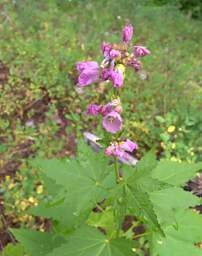 |
| Flower Xxx Purple | |
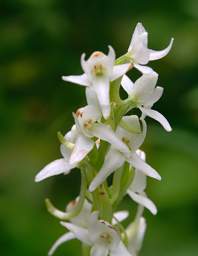 |
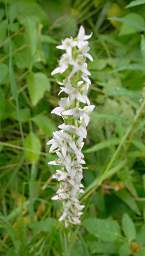 |
| Flower Xxx White Stalk | |
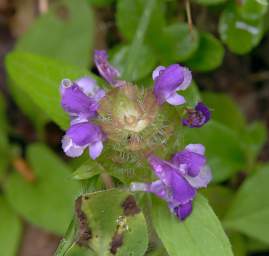 |
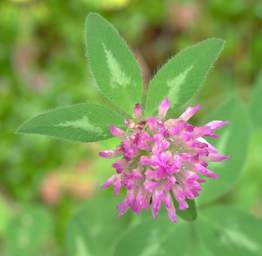 |
| Flower Xxx Blue Purple | Flower Xxx Purple |
 |
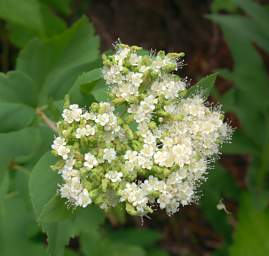 |
| Flower Xxx Yellow | Flower Xxx White Cluster |
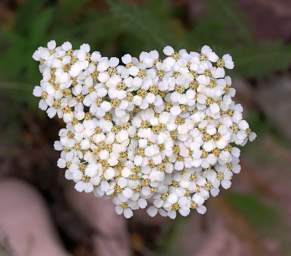 |
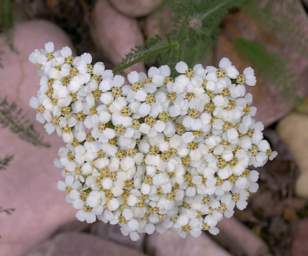 |
| Flower Xxx White Cluster | |
There was reasonably fresh bear scat in a few places, but unfortunately I didn't see any of the responsible parties.
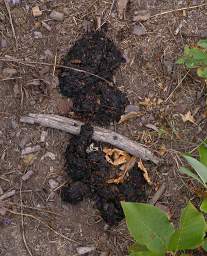 |
 |
| Bear Scat | |
I got about a third of the way up Pagoda mountain and decided to turn around. It was overcast and not looking to get any better any time soon, and the peak was in the clouds. There also didn't appear to be any good vantage point coming up. And finally, I realized I had left my headlamp in the tent in camp. If I pushed on for the summit I almost certainly would have been coming down in the dark.
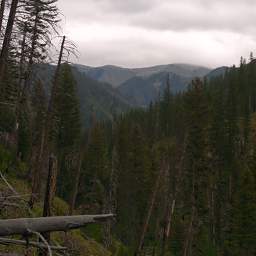 |
| Pagoda Mountain In Clouds |
 |
| Upriver From Camp |
The next day we continued on down the river, fishing as we went, but it was uninspiring. Wayne put on what I call his dredging line, a long section of leaded sink-tip designed to get down and stay down. We caught fish, but nothing to write home about.
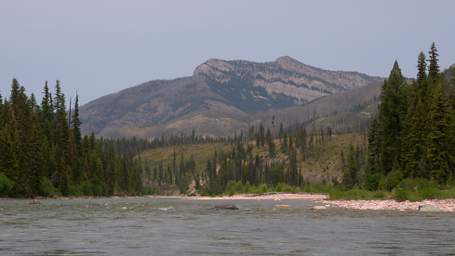 |
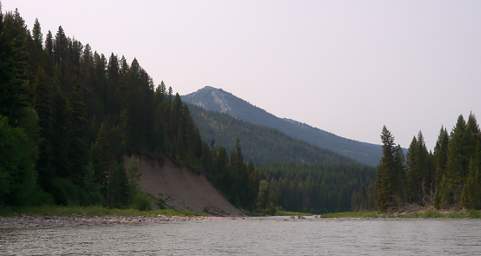 |
| South Fork Flathead River | |
 |
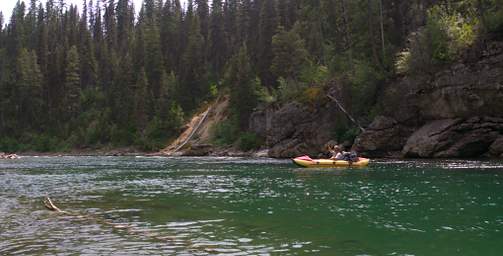 |
| Wayne Fishing | |
We camped for the night a few miles below the Black Bear pack bridge. Wayne had a leaky dry bag and had to dry out his sunflowers. I found more leaks in my waders and patched them again.
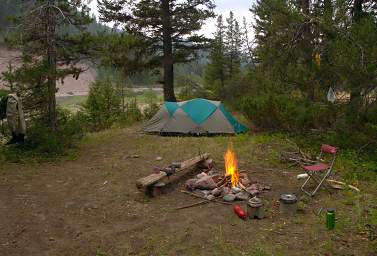 |
| Camp below Black Bear |
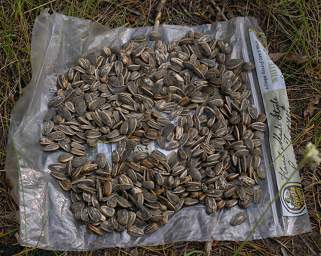 |
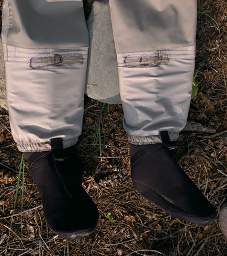 |
| Sunflowers Drying | Waders Repatched |
We had a fish dinner planned but had only kept one fish and needed another. While I rigged up the line to hang the food bags, Wayne went down to the river to fish. While he was pawing through his fly box deciding what to do, a fish grabbed the fly on the end of his line dragging in the water. It was a nice plump eleven incher, just right for the pan, and he was kind of tired of fishing anyway. He filleted the two trout, stirred up a great marinade, and proceeded to cook us up another incredible meal. It was just about the best fish I've ever eaten, with wine to go with it.
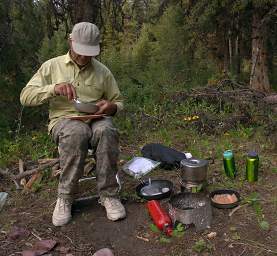 |
| Preparing Marinade For Trout Fillets |
Hanging food sufficiently high and sufficiently far out from tree trunks can be an issue. If you're in a well-used camp, there is often a game pole strung between two trees high enough to serve as a food pole and you can simply throw a rope over it. But in most camps, you have to rig something up.
Here's how I do it. I bring a rescue pully rigged in the middle of a 50 foot line, so there is 25 feet to each side of the pulley. The food hanging line goes through the pulley. When it's time to hang food, I locate two trees without too many branches and far enough apart. I tie the food line's ends together and tie that to a bush about in the center between the two trees. I tie a rock to the end of one line on the pulley and throw it over a branch as high as I can on one tree, then work the line down to the crotch where the branch joins the tree. I pull in the line until the pulley is partly raised and looks to be where it will end up about half way between the two trees when the line is pulled taught from the other end. Then I lead the line part way around the tree and over to another tree and tie it off, or lead it down to a sturdy branch on the same tree and tie it off. Then I attach the rock to the other line end coming from the pulley and repeat the process with the other tree. Once both lines are up and the pulley is raised, the lines can be adjusted so the pulley is more or less in the middle. Then I make the lines as tight as possible, tie on the food bags and raise them. The lines have to be quite a bit more than ten feet above the ground for the food to end up ten feet up when it's raised, as the line stretches some when weight is applied.
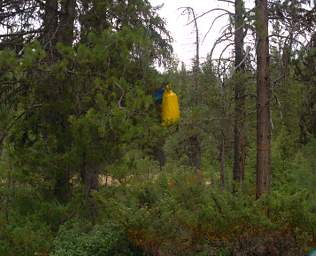 |
| Food Hanging |
The next day was still overcast, and it was our last on this wild portion of the river. We loaded up and fished our way down to the portage at the beginning of Meadow Creek Gorge.
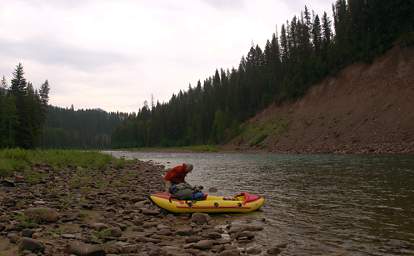 |
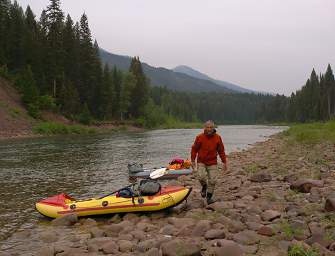 |
| Loading Up | Ready To Go |
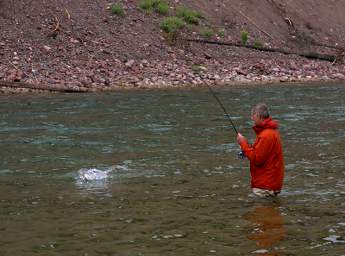 |
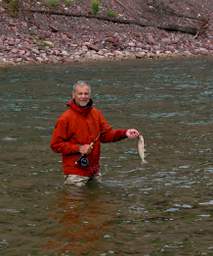 |
| Fish On! | Typical South Fork Flathead Cutthroat |
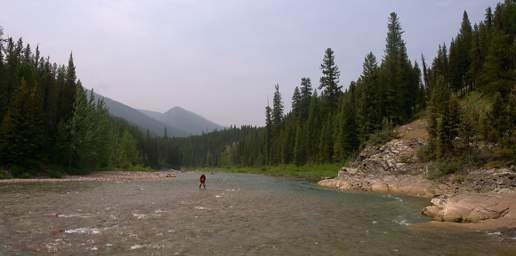 |
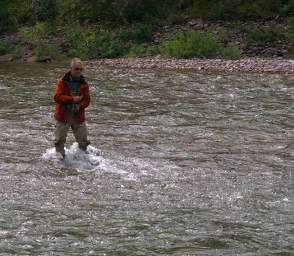 |
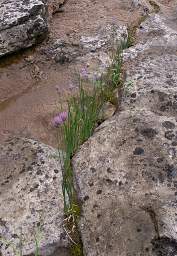 |
 |
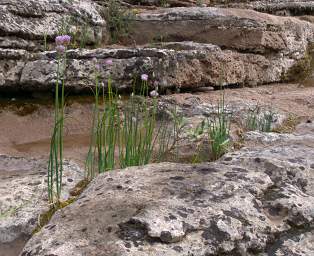 |
| Onions | Pool of Pebbles | Onions |
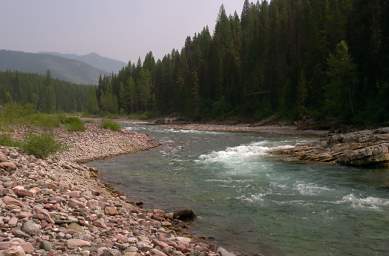 |
 |
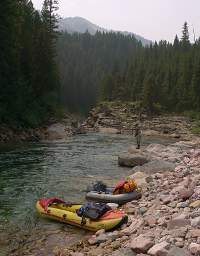 |
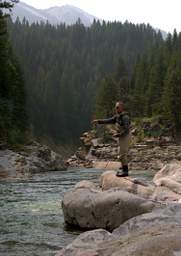 |
| Not the Take-out | |
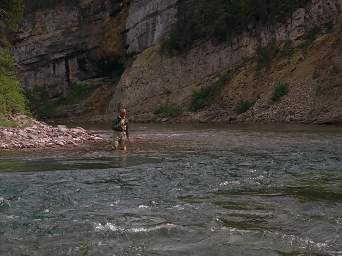 |
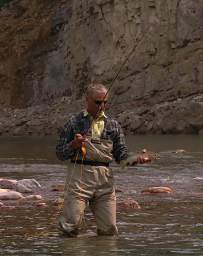 |
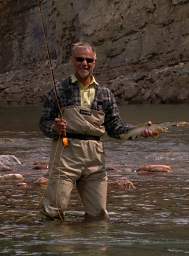 |
| Wayne with a Fish on | Wayne with Cutthroat | |
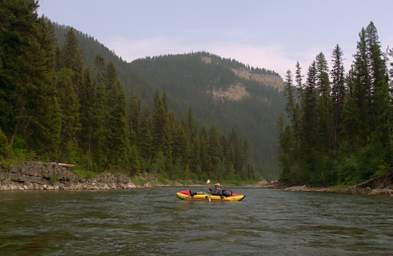 |
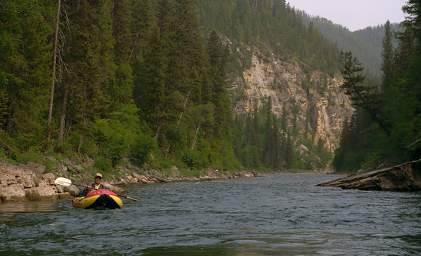 |
At one point Wayne said something like "I wonder how high the water gets?" I looked ahead and pointed -- "That high!" Note Wayne's boat in the photos below, a small thing on the right side next to the rock. That sucker is a ways up, and that would be a heck of a lot of water!
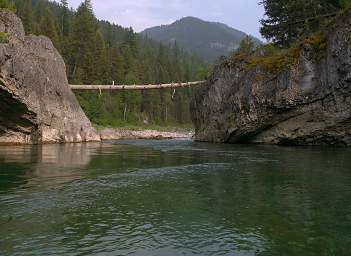 |
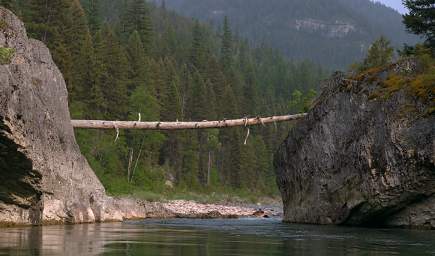 |
| High Water Log Spanning River | |
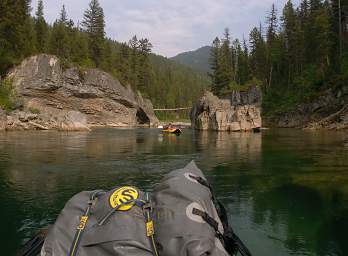 |
 |
Having never been to the portage take-out, and not having a picture of it, we weren't sure what to expect. We had read there was a sign and it was hard to miss.
As we worked our way down the river we came to more than one "gorge-like" passage with no sign. We would look it over carefully, particularly the back side, to make sure we could get out if we went through; then we'd paddle through.
Eventually we passed an insignificant looking beat up sign on a standard-sized piece of paper. In weathered writing it said something like "Take out 1/4 mile ahead".
About that far ahead we came to a rapid leading into a slot between two cliffs. There was a large-ish weathered sign up on one of the cliffs which I couldn't read well but which I assumed announced this as the take-out. As I floated down the rapid I made sure I stayed to river right; there looked to be some large waves or a hole near the eddy at the bottom right before the cliff, the only sane take-out point.
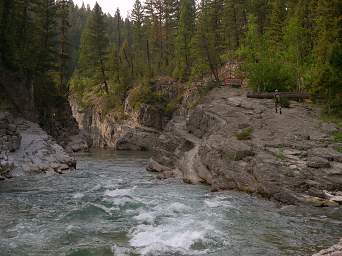 |
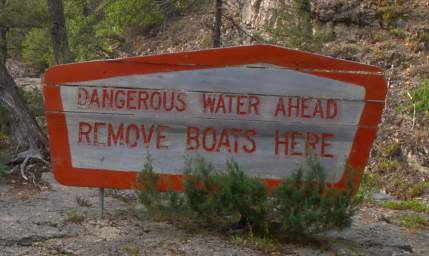 |
| Meadow Cr Gorge Take Out | Takeout Sign |
Downstream of the takeout, the water is smooth and inviting. You can't help but wonder... how bad does it get if I keep going?
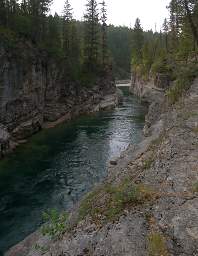 |
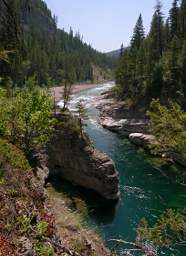 |
| Downstream Of Takeout | Looking Upstream
from below Takeout |
If you're going to be doing this trip, look at the two pictures below carefully. Note that all the water in the river wants to keep going; there is very little going into the eddy on river right. Furthermore, the only route into the eddy is along the bank at river right at the very head of the eddy (left part of picture). The wave below there may not look very big, but in most loaded inflatables you won't be able to punch through it into the eddy. The water in the bottom half of the eddy line is heading strongly on down the river.
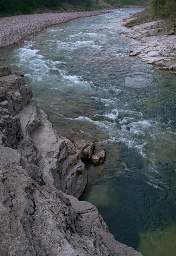 |
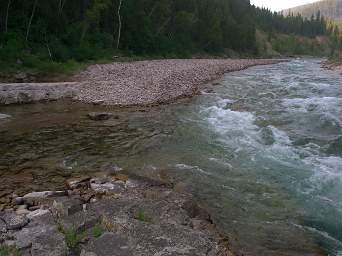 |
| Looking Upstream from Takeout Sign | Takeout Eddy |
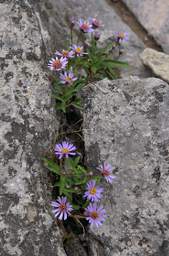 |
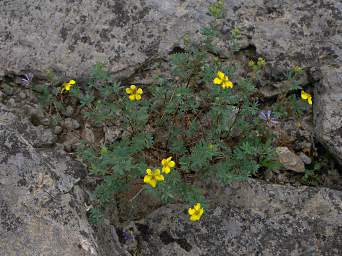 |
| Aster | Flower Xxx Yellow |
We emptied the boats, set up camp, and hung everything up to dry. We had a long slog coming up to portage out, and there was no sense in hauling heavier water soaked stuff.
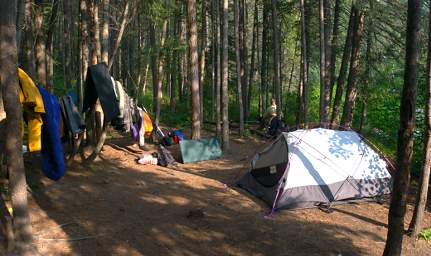 |
| Takeout Camp |
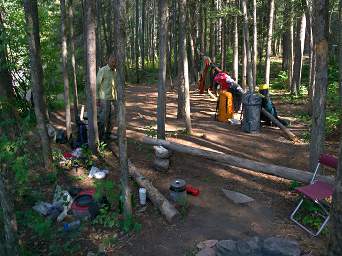 |
 |
| Takeout Camp | Drying Rack |
The next morning as we were packing up, two forest Service river rangers arrived in their alpackas. Tough job -- float the river, talk to people, go back up and float again... They informed us we had to put out our fire, as stage 1 fire restrictions had been put in place a few days earlier.
I headed out with my first load while the rangers were still unloading and Wayne was still packing up. The walk wouldn't have been too bad with a proper pack with hip support, but I was carrying a Bill's Bag and they don't have any waist strap. I envied the rangers and their proper backpacks and light boats.
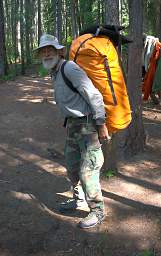 |
| Gary Starting the Portage |
You get glimpses of Meadow Creek Gorge on the way out. Most of it is pleasant looking, and most of the rapids look pretty runnable. And there are some places where it looks like you can get out. There just isn't a trail and it wouldn't be very pleasant. But then there are a few other places, and some places you can't see...
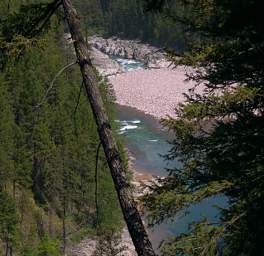 |
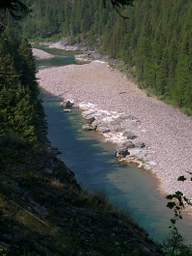 |
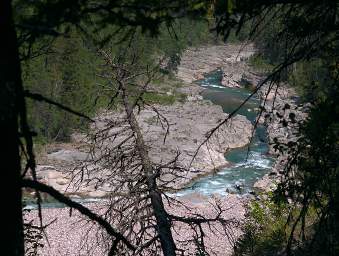 |
| Meadow Creek Gorge | ||
 |
On my way out I met a backpacker heading up the trail, a happy guy on a two week trip. On the way back for my second load I noticed some leaves in the trail, a cheerful note from him. Whoever you are, thanks!
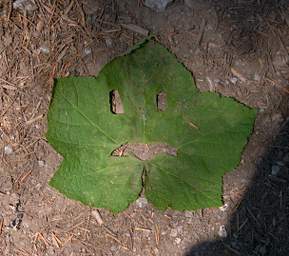 |
 |
| Happy Face Leaf | |
After three miles or so you come to the Meadow Creek Gorge pack bridge, where Dona and I had camped and hiked a few weeks before. The river looked about the same, but was actually flowing much less. When we started the trip it was flowing about 1800 cfs, and when we ended, 900 cfs.
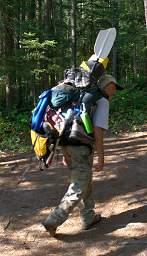 |
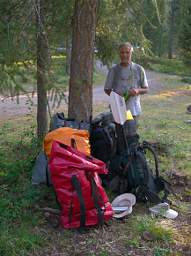 |
| Wayne heading out | Gear After Portage |
There was a very nice fellow from California parked in the place where I had planned to camp, if it came to that. He agreed to haul us and our gear the two miles down the road to the Cedar Flats put in. So after a brief rest Dave DeRuysscher helped pile us and our gear into the back of his truck and off we went. Thanks again a bazillion, Dave! And come visit any time.
During my treks back and forth to portage our gear out I took as many pictures of the gorge and its rapids as I could with the idea of maybe running it in the future. I didn't have a long lens with me, but you can get a good idea of what's down there. Meadow Creek Gorge